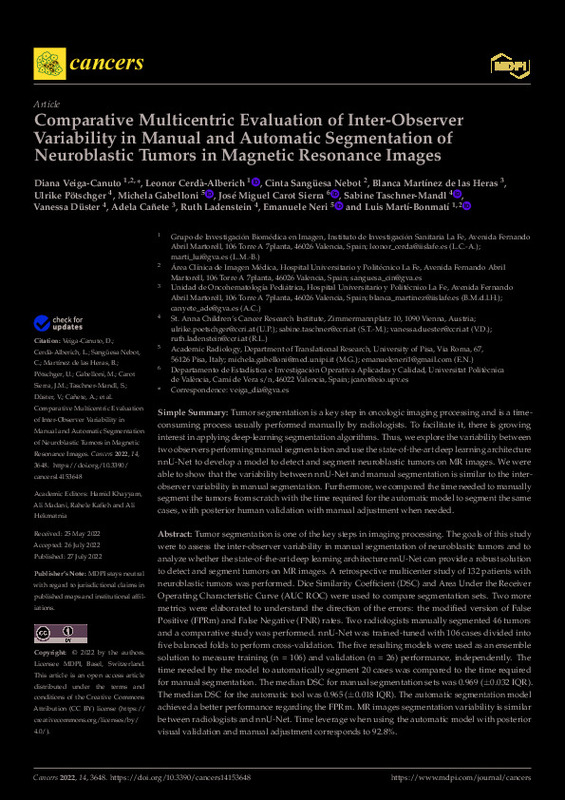JavaScript is disabled for your browser. Some features of this site may not work without it.
Buscar en RiuNet
Listar
Mi cuenta
Estadísticas
Ayuda RiuNet
Admin. UPV
Comparative Multicentric Evaluation of Inter-Observer Variability in Manual and Automatic Segmentation of Neuroblastic Tumors in Magnetic Resonance Images
Mostrar el registro sencillo del ítem
Ficheros en el ítem
| dc.contributor.author | Veiga-Canuto, Diana
|
es_ES |
| dc.contributor.author | Cerdà-Alberich, Leonor
|
es_ES |
| dc.contributor.author | Sangüesa Nebot, Cinta
|
es_ES |
| dc.contributor.author | Martínez de las Heras, Blanca
|
es_ES |
| dc.contributor.author | Pötschger, Ulrique
|
es_ES |
| dc.contributor.author | Gabelloni, Michela
|
es_ES |
| dc.contributor.author | Carot Sierra, José Miguel
|
es_ES |
| dc.contributor.author | Taschner-Mandl, Sabine
|
es_ES |
| dc.contributor.author | Düster, Vanessa
|
es_ES |
| dc.contributor.author | Cañete, Adela
|
es_ES |
| dc.contributor.author | Ladenstein, Ruth
|
es_ES |
| dc.contributor.author | Neri, Emanuele
|
es_ES |
| dc.contributor.author | Marti-Bonmati, Luis
|
es_ES |
| dc.date.accessioned | 2023-05-16T18:01:11Z | |
| dc.date.available | 2023-05-16T18:01:11Z | |
| dc.date.issued | 2022-08 | es_ES |
| dc.identifier.uri | http://hdl.handle.net/10251/193435 | |
| dc.description.abstract | [EN] Simple Summary Tumor segmentation is a key step in oncologic imaging processing and is a time-consuming process usually performed manually by radiologists. To facilitate it, there is growing interest in applying deep-learning segmentation algorithms. Thus, we explore the variability between two observers performing manual segmentation and use the state-of-the-art deep learning architecture nnU-Net to develop a model to detect and segment neuroblastic tumors on MR images. We were able to show that the variability between nnU-Net and manual segmentation is similar to the inter-observer variability in manual segmentation. Furthermore, we compared the time needed to manually segment the tumors from scratch with the time required for the automatic model to segment the same cases, with posterior human validation with manual adjustment when needed. Tumor segmentation is one of the key steps in imaging processing. The goals of this study were to assess the inter-observer variability in manual segmentation of neuroblastic tumors and to analyze whether the state-of-the-art deep learning architecture nnU-Net can provide a robust solution to detect and segment tumors on MR images. A retrospective multicenter study of 132 patients with neuroblastic tumors was performed. Dice Similarity Coefficient (DSC) and Area Under the Receiver Operating Characteristic Curve (AUC ROC) were used to compare segmentation sets. Two more metrics were elaborated to understand the direction of the errors: the modified version of False Positive (FPRm) and False Negative (FNR) rates. Two radiologists manually segmented 46 tumors and a comparative study was performed. nnU-Net was trained-tuned with 106 cases divided into five balanced folds to perform cross-validation. The five resulting models were used as an ensemble solution to measure training (n = 106) and validation (n = 26) performance, independently. The time needed by the model to automatically segment 20 cases was compared to the time required for manual segmentation. The median DSC for manual segmentation sets was 0.969 (+/- 0.032 IQR). The median DSC for the automatic tool was 0.965 (+/- 0.018 IQR). The automatic segmentation model achieved a better performance regarding the FPRm. MR images segmentation variability is similar between radiologists and nnU-Net. Time leverage when using the automatic model with posterior visual validation and manual adjustment corresponds to 92.8%. | es_ES |
| dc.description.sponsorship | This study was funded by PRIMAGE (PRedictive In silico Multiscale Analytics to support cancer personalized diaGnosis and prognosis, empowered by imaging biomarkers), a Horizon 2020 | RIA project (Topic SC1-DTH-07-2018), grant agreement no: 826494. | es_ES |
| dc.language | Inglés | es_ES |
| dc.publisher | MDPI AG | es_ES |
| dc.relation.ispartof | Cancers | es_ES |
| dc.rights | Reconocimiento (by) | es_ES |
| dc.subject | Tumor segmentation | es_ES |
| dc.subject | Neuroblastic tumors | es_ES |
| dc.subject | Deep learning | es_ES |
| dc.subject | Manual segmentation | es_ES |
| dc.subject | Automatic segmentation | es_ES |
| dc.subject | Inter-observer variability | es_ES |
| dc.subject.classification | ESTADISTICA E INVESTIGACION OPERATIVA | es_ES |
| dc.title | Comparative Multicentric Evaluation of Inter-Observer Variability in Manual and Automatic Segmentation of Neuroblastic Tumors in Magnetic Resonance Images | es_ES |
| dc.type | Artículo | es_ES |
| dc.identifier.doi | 10.3390/cancers14153648 | es_ES |
| dc.relation.projectID | info:eu-repo/grantAgreement/EC/H2020/826494/EU | es_ES |
| dc.rights.accessRights | Abierto | es_ES |
| dc.contributor.affiliation | Universitat Politècnica de València. Escuela Técnica Superior de Ingenieros Industriales - Escola Tècnica Superior d'Enginyers Industrials | es_ES |
| dc.description.bibliographicCitation | Veiga-Canuto, D.; Cerdà-Alberich, L.; Sangüesa Nebot, C.; Martínez De Las Heras, B.; Pötschger, U.; Gabelloni, M.; Carot Sierra, JM.... (2022). Comparative Multicentric Evaluation of Inter-Observer Variability in Manual and Automatic Segmentation of Neuroblastic Tumors in Magnetic Resonance Images. Cancers. 14(15):1-15. https://doi.org/10.3390/cancers14153648 | es_ES |
| dc.description.accrualMethod | S | es_ES |
| dc.relation.publisherversion | https://doi.org/10.3390/cancers14153648 | es_ES |
| dc.description.upvformatpinicio | 1 | es_ES |
| dc.description.upvformatpfin | 15 | es_ES |
| dc.type.version | info:eu-repo/semantics/publishedVersion | es_ES |
| dc.description.volume | 14 | es_ES |
| dc.description.issue | 15 | es_ES |
| dc.identifier.eissn | 2072-6694 | es_ES |
| dc.identifier.pmid | 35954314 | es_ES |
| dc.identifier.pmcid | PMC9367307 | es_ES |
| dc.relation.pasarela | S\471675 | es_ES |
| dc.contributor.funder | European Commission | es_ES |








